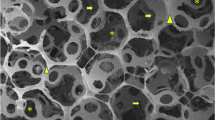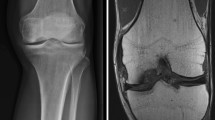Abstract
Purpose
The purpose of this study was to examine the effect of subperiosteal injection of chondroinductive growth factors on the histological and biomechanical outcome of autologous osteoperiosteal grafts.
Methods
Thirty six standardised osteochondral defects were created in the trochlear groove of 18 Göttinger Minipigs and evaluated after six, 12 and 52 weeks. Defects were treated with press-fit implantation of autologous osteoperiosteal cylindrical block-grafts with or without subperiosteal injection of a chondroinductive growth factor mixture (GFM).
Results
Histomorphological analysis showed complete osseointegration of all grafts from six weeks. The periosteum remained in place in 35 of 36 cases. Fibrocartilagineous repair tissue formation occurred at the cambium layer with a maximum at 12 weeks in both groups. Histomorphological grading and biomechanical testing showed highest values at 12 weeks, with signs of tissue degradation at one year. There was no significant difference between both groups.
Conclusion
Transplantation of autologous osteoperiosteal grafts is an effective method to restore subchondral bone defects, but not the overlying cartilage as the repair tissue deteriorates in the long term. Subperiosteal growth factors injection did not stimulate tissue differentiation on a biomechanical and histomorphological level.




Similar content being viewed by others
References
Peterson L, Vasiliadis HS, Brittberg M, Lindahl A (2010) Autologous chondrocyte implantation: a long-term follow-up. Am J Sports Med 38:1117–1124
Hangody L, Vasarhelyi G, Hangody LR, Sukosd Z, Tibay G, Bartha L, Bodo G (2008) Autologous osteochondral grafting–technique and long-term results. Injury 39(Suppl 1):S32–S39
Bentley G, Biant LC, Vijayan S, Macmull S, Skinner JA, Carrington RW (2012) Minimum ten-year results of a prospective randomised study of autologous chondrocyte implantation versus mosaicplasty for symptomatic articular cartilage lesions of the knee. J Bone Joint Surg Br 94:504–509
Krych AJ, Harnly HW, Rodeo SA, Williams RJ 3rd (2012) Activity levels are higher after osteochondral autograft transfer mosaicplasty than after microfracture for articular cartilage defects of the knee: a retrospective comparative study. J Bone Joint Surg Am 94:971–978
Bedi A, Feeley BT, Williams RJ 3rd (2010) Management of articular cartilage defects of the knee. J Bone Joint Surg Am 92:994–1009
Horas U, Pelinkovic D, Herr G, Aigner T, Schnettler R (2003) Autologous chondrocyte implantation and osteochondral cylinder transplantation in cartilage repair of the knee joint: a prospective, comparative trial. J Bone Joint Surg Am 85-A:185–192
Joshi N, Reverte-Vinaixa M, Diaz-Ferreiro EW, Dominguez-Oronoz R (2012) Synthetic resorbable scaffolds for the treatment of isolated patellofemoral cartilage defects in young patients: magnetic resonance imaging and clinical evaluation. Am J Sports Med 40:1289–1295
Dhollander AA, Liekens K, Almqvist KF, Verdonk R, Lambrecht S, Elewaut D, Verbruggen G, Verdonk PC (2012) A pilot study of the use of an osteochondral scaffold plug for cartilage repair in the knee and how to deal with early clinical failures. Arthroscopy 28:225–233
Tarng YW, Huang BF, Su FC (2012) A novel recirculating flow-perfusion bioreactor for periosteal chondrogenesis. Int Orthop 36:863–868
O’Driscoll SW, Fitzsimmons JS (2001) The role of periosteum in cartilage repair. Clin Orthop:S190–207
Ito Y, Fitzsimmons JS, Sanyal A, Mello MA, Mukherjee N, O’Driscoll SW (2001) Localization of chondrocyte precursors in periosteum. Osteoarthr Cartil 9:215–223
Korkala O, Kuokkanen H (1991) Autogenous osteoperiosteal grafts in the reconstruction of full-thickness joint surface defects. Int Orthop 15:233–237
Pecina M, Jelic M, Martinovic S, Haspl M, Vukicevic S (2002) Articular cartilage repair: the role of bone morphogenetic proteins. Int Orthop 26:131–136
Miura Y, Parvizi J, Fitzsimmons JS, O’Driscoll SW (2002) Brief exposure to high-dose transforming growth factor-beta1 enhances periosteal chondrogenesis in vitro: a preliminary report. J Bone Joint Surg Am 84-A:793–799
Fukumoto T, Sperling JW, Sanyal A, Fitzsimmons JS, Reinholz GG, Conover CA, O’Driscoll SW (2003) Combined effects of insulin-like growth factor-1 and transforming growth factor-beta1 on periosteal mesenchymal cells during chondrogenesis in vitro. Osteoarthr Cartil 11:55–64
Reinholz GG, Fitzsimmons JS, Casper ME, Ruesink TJ, Chung HW, Schagemann JC, O’Driscoll SW (2009) Rejuvenation of periosteal chondrogenesis using local growth factor injection. Osteoarthr Cartil 17:723–734
Olivos-Meza A, Fitzsimmons JS, Casper ME, Chen Q, An KN, Ruesink TJ, O’Driscoll SW, Reinholz GG (2010) Pretreatment of periosteum with TGF-beta1 in situ enhances the quality of osteochondral tissue regenerated from transplanted periosteal grafts in adult rabbits. Osteoarthr Cartil 18:1183–1191
Gotterbarm T, Reitzel T, Schneider U, Voss HJ, Stofft E, Breusch SJ (2003) Integration of periosteum covered autogenous bone grafts with and without autologous chondrocytes. An animal experiment using the Gottinger minipig. Orthopäde 32:65–73
Jung M, Gotterbarm T, Gruettgen A, Vilei SB, Breusch S, Richter W (2005) Molecular characterization of spontaneous and growth-factor-augmented chondrogenesis in periosteum-bone tissue transferred into a joint. Histochem Cell Biol 123:447–456
Gotterbarm T, Breusch SJ, Schneider U, Jung M (2008) The minipig model for experimental chondral and osteochondral defect repair in tissue engineering: retrospective analysis of 180 defects. Lab Anim 42:71–82
Jung M, Breusch S, Daecke W, Gotterbarm T (2009) The effect of defect localization on spontaneous repair of osteochondral defects in a Gottingen minipig model: a retrospective analysis of the medial patellar groove versus the medial femoral condyle. Lab Anim 43:191–197
Spies CK, Schnurer S, Gotterbarm T, Breusch S (2009) The efficacy of Biobon and Ostim within metaphyseal defects using the Gottinger Minipig. Arch Orthop Trauma Surg 129:979–988
Boden SD, Grob D, Damien C (2004) Ne-Osteo bone growth factor for posterolateral lumbar spine fusion: results from a nonhuman primate study and a prospective human clinical pilot study. Spine 29:504–514
Damien CJ, Grob D, Boden SD, Benedict JJ (2002) Purified bovine BMP extract and collagen for spine arthrodesis: preclinical safety and efficacy. Spine 27:S50–S58
Atkinson BL, Fantle KS, Benedict JJ, Huffer WE, Gutierrez-Hartmann A (1997) Combination of osteoinductive bone proteins differentiates mesenchymal C3H/10 T1/2 cells specifically to the cartilage lineage. J Cell Biochem 65:325–339
Gotterbarm T, Richter W, Jung M, Berardi Vilei S, Mainil-Varlet P, Yamashita T, Breusch SJ (2006) An in vivo study of a growth-factor enhanced, cell free, two-layered collagen-tricalcium phosphate in deep osteochondral defects. Biomaterials 27:3387–3395
Mainil-Varlet P, Van Damme B, Nesic D, Knutsen G, Kandel R, Roberts S (2010) A new histology scoring system for the assessment of the quality of human cartilage repair: ICRS II. Am J Sports Med 38:880–890
Jackson DW, Lalor PA, Aberman HM, Simon TM (2001) Spontaneous repair of full-thickness defects of articular cartilage in a goat model. A preliminary study. J Bone Joint Surg Am 83-A:53–64
Brown TD, Pope DF, Hale JE, Buckwalter JA, Brand RA (1991) Effects of osteochondral defect size on cartilage contact stress. J Orthop Res 9:559–567
Feczko P, Hangody L, Varga J, Bartha L, Dioszegi Z, Bodo G, Kendik Z, Modis L (2003) Experimental results of donor site filling for autologous osteochondral mosaicplasty. Arthroscopy 19:755–761
Steinhagen J, Bruns J, Deuretzbacher G, Ruether W, Fuerst M, Niggemeyer O (2010) Treatment of osteochondritis dissecans of the femoral condyle with autologous bone grafts and matrix-supported autologous chondrocytes. Int Orthop 34:819–825
O’Driscoll SW, Salter RB (1984) The induction of neochondrogenesis in free intra-articular periosteal autografts under the influence of continuous passive motion. An experimental investigation in the rabbit. J Bone Joint Surg Am 66:1248–1257
van Susante JL, Wymenga AB, Buma P (2003) Potential healing benefit of an osteoperiosteal bone plug from the proximal tibia on a mosaicplasty donor-site defect in the knee. An experimental study in the goat. Arch Orthop Trauma Surg 123:466–470
Draenert K, Draenert Y (1988) A new procedure for bone biopsies and cartilage and bone transplantation. Sandorama III–IV:33–40
Narcisi R, Quarto R, Ulivi V, Muraglia A, Molfetta L, Giannoni P (2012) TGF beta-1 administration during ex vivo expansion of human articular chondrocytes in a serum-free medium redirects the cell phenotype toward hypertrophy. J Cell Physiol 227:3282–3290
Watson RS, Gouze E, Levings PP, Bush ML, Kay JD, Jorgensen MS, Dacanay EA, Reith JW, Wright TW, Ghivizzani SC (2010) Gene delivery of TGF-beta1 induces arthrofibrosis and chondrometaplasia of synovium in vivo. Lab Invest 90:1615–1627
Gruber R, Mayer C, Bobacz K, Krauth MT, Graninger W, Luyten FP, Erlacher L (2001) Effects of cartilage-derived morphogenetic proteins and osteogenic protein-1 on osteochondrogenic differentiation of periosteum-derived cells. Endocrinology 142:2087–2094
Acknowledgments
This work was funded by Centerpulse Biologics, Winterthur, Switzerland and the Research Fund of the Orthopaedic Department of the University of Heidelberg. The authors thank Dr. vet. H. Lorenz, R. Föhr, K. Goetzke, and M. Daniels for their excellent work and J.-F. Clémence for his support during the experimental procedures.
Author information
Authors and Affiliations
Corresponding author
Additional information
This work was supported by Centerpulse Biologics, Inc., Winterthur, Switzerland.
Rights and permissions
About this article
Cite this article
Gotterbarm, T., Breusch, S.J., Vilei, S.B. et al. No effect of subperiosteal growth factor application on periosteal neo-chondrogenesis in osteoperiosteal bone grafts for osteochondral defect repair. International Orthopaedics (SICOT) 37, 1171–1178 (2013). https://doi.org/10.1007/s00264-013-1827-3
Received:
Accepted:
Published:
Issue Date:
DOI: https://doi.org/10.1007/s00264-013-1827-3




